
One of the words often used to describe horror movies is “chilling.” The idea behind this description is the anxiety and fear many experience when they watch a horror movie and the resulting sensation of chills.
Anxiety is often connected with experiencing “chills,” yet the exact mechanism of the relationship between anxiety and the sensation remains somewhat unclear. What is it about anxiety that causes a chill to run down your spine, and why do some people experience such chills more than others?
Chills Before Attacks
Some people report that experiencing chills is, for them, an indicator (or an early warning sign) that an anxiety attack is coming. Essentially, while chills can be uncomfortable, they can also give a person insight that increased anxiety is on the horizon and it might be a good time to make use of helpful coping skills.
Chills are incredibly common and are often caused by anxiety. Depending on the person, and the type(s) of anxiety they experience, chills may arise for different reasons.
The most common contributing factors to a person’s experience of the “chills” follow:
Rapid Change in Body Temperature
During times of anxiety, the body prepares to enter into fight-or-flight mode, essentially preparing for “battle.” In a way, the body instantly and automatically prepares to face danger (whether or not there is an actual threat).
One of the ways the body does this is by lowering the internal body temperature (through goosebumps and possibly a change in the hypothalamus). The lowering of body temperature occurs in preparation for the body to drastically increase its temperature during the fight/flight mode. This lowered body temperature can often contribute to the sensation of chills. After a period of time, the body adjusts to the cold, often enabling the person to feel “normal” again.
Sweat Chills
Chills occur often when a person is cold. During times of increased anxiety, a person’s body often sweats (this is one way in which the body notifies the person of potential danger/fear). Sweating is also designed to cool the body, so a person may experience genuine chills as a result of this sweat. Also, it is not uncommon for someone to not even recognize they are sweating during times of anxiety until the onset of cold chills.
Redirecting the Blood Flow
Anxiety and the body’s fight or flight response may also trigger the redirection of blood flow to areas of the body that are signaling the greatest need for it, for instance, the heart. This means the blood is being taken away from some areas of the body to serve those that are most in need. The areas of the body from which the blood is being taken still need a certain amount of blood flow to function, and, with the decreased blood flow, those areas of the body become cooler. The body usually adjusts over time, but, until it does, the person may feel cold.
Hyperventilation
Hyperventilation is a common symptom of anxiety. It occurs when a person breathes too quickly or breathes in too much oxygen as a result of stress. When the person is hyperventilating, their body struggles to move blood around, which can result in lowered body temperature. The person may feel genuinely cold or may simply experience the sensation of chills until the body adjusts.
Standard Chills
As previously stated, chills can occur for a variety of reasons. Of course, they can be a sign that a person is cold or may indicate that the person is surprised or significantly “moved” by something (e.g., a song). But when a person has anxiety, he or she may overreact or overthink their experience of chills and believe they are caused by some other more serious issue.
Safe Way to Stop Cold Chills
Some people are greatly disturbed by the cold chills they experience. Cold chills, in general, cause no harm. While it is possible for some chills to last a significant length of time (and, therefore, be somewhat irritating), they tend to come and go, and little extra work is necessary to manage and/or avoid them.
Cold chills tend to be related to anxiety. Because they are common during periods of intense anxiety, such as panic attacks, the anxiety rather than the chills themselves should be targeted.
However, if the chills are hugely uncomfortable, a person can try to do a few things to better manage them:
Bundle Up
Chills, whether related to anxiety or not, are connected to changes in body temperature. Although they cannot always be controlled by heat (and often occur during heat when your body is sweating or adjusting), some people find that wrapping up in coats, blankets, etc. helps them feel warmer and prevents their bodies from becoming any colder
Walk Around
Stimulating the blood flow can be helpful in managing the chills as well. Getting up and walking around will not necessarily stop the chills (especially if an anxiety attack is coming), but it can warm a person up to some extent and ensure that the body reaches a more comfortable stasis.
Breathing Techniques
The way a person breathes can affect their anxiety levels and contribute to the development of chills. Fighting the urge to take deep breaths and, instead, slowing their breathing can help them manage both the anxiety and the chills.
If a person’s chills significantly impair their life or well-being, it is advised to see a medical professional. Rarely do people see doctors because of chills alone, but there is no harm in doing that as a doctor can help ease one’s mind about any underlying health worries.
SUMMARY:
During periods of intense anxiety, blood flow, perspiration, and heart rate all change rapidly. These are some of the direct effects of anxiety that can lead to feeling chills. This experience is usually automatic, and the symptom itself may be difficult to prevent, but reducing anxiety should reduce the frequency and severity of chills.










